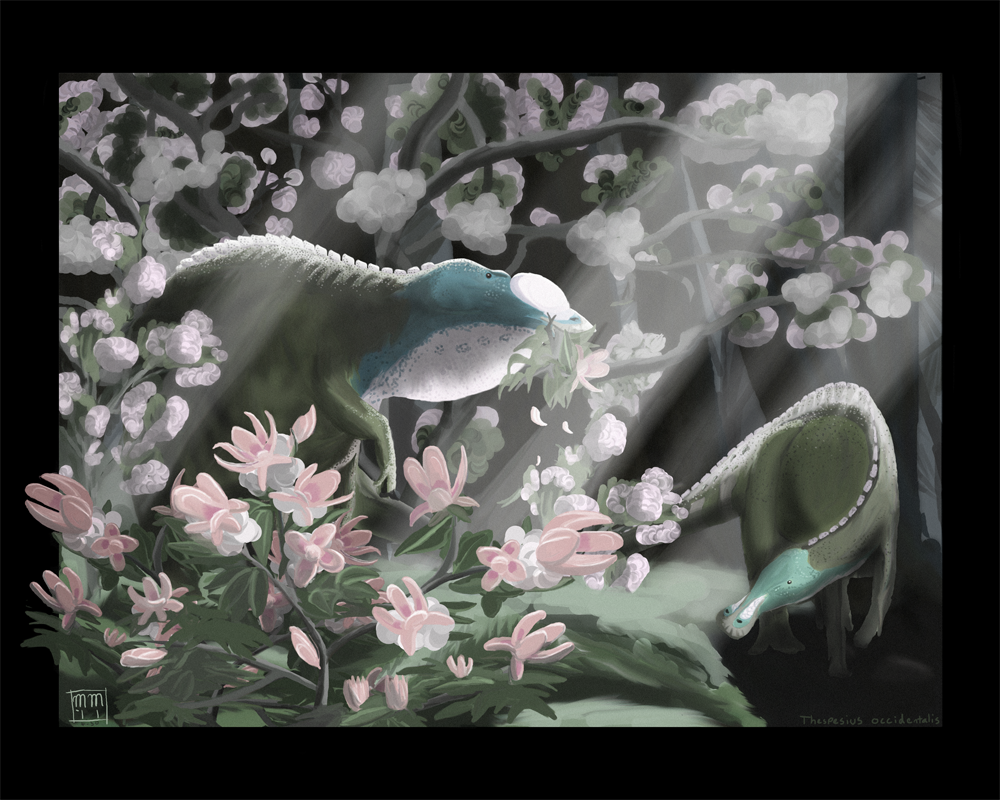home > natural history
Edmontosaurus annectens
"connecting edmontosaur"

Hadrosaurid classification has historically been some of the messiest of all archosaurs. Nowhere is this better illustrated than in the case of Thespesius. A look at the list of synonyms (right) will show a few of the 'major' taxa that have been named for specimens which all likely belong to this one species, though many additional combinations of those genera and species have been proposed since fossils of this animal were first described and named in 1852 by pioneering American paleontologist Joseph Leidy. Leidy found several distinctive vertebrae in the Lance formation of Wyoming. Noting that they must have belonged to a truly grand animal, he named them Thespesius occidentalis, or "western wondrous one."
Leidy's discovery was overshadowed by more spectacular remains found during the Bone Wars by Cope and Marsh. Marsh identified more complete hadrosaurid remains from the Lance, which he believed belonged to the previously named Claosaurus, but he named a new species, C. annectens. Meanwhile, Cope recovered a larger, nearly complete skeleton from the contemporary Hell Creek formation, which he believed belonged to the Campanian species Trachodon (Cope's Diclonius) mirabilis. Additional specimens were usually referred to these genera or new ones. Hatcher famously considered nearly all saurolophine hadrosaurids to belong to Trachodon spp., which was followed for the first part of the 20th Century until later workers began to split them again, but in new combinations and with newer genera such as Anatosaurus, Edmontosaurus, and Anatotitan. In 1915, Gilmore suggested that Thespesius should be used for the Lance age hadrosaurs, and that Trachodon be restricted to the Judith River formation and equivalents. Unrecognized by Gilmore and later authors is how huge a difference existed in the lengths of these ages. What we now recognize as Lance age lasted at most 3 million years, from 67-65.5 million years ago. On the other hand, the Judith River Formation at the time encompassed over ten million years of time and hosted several distinct faunas over that period. We now know about a wealth of hadrosaurid diversity from the Judith River and those formations previously considered equivalents but since spun off, such as the Dinosaur Park Formation. However, the hadrosaur diversity of the Lance age is still restricted to the few morphotypes known to Gilmore.
Recent research is beginning to suggest that even that supposed Lancian diversity is an illusion. The most common form is the fairly small Edmontosaurus annectens (the type species of Anatosaurus, but synonymized subjectively by most researchers). Less common are Anatotitan copei and Edmontosaurus saskatchewanensis. The later is considered my most people to represent a young E. annectens. Current research has begun to point to the likelihood that A. copei (as well as its often ignored senior synonym A. longiceps) is simply an old, adult form of E. annectens. If this is the case then Gilmore was right: there's only one species of hadrosaurid in the Lance. And, as Gilmore pointed out, the proper, oldest name for this species is Leidy's Thespesius occidentalis.
This hypothesis is illustrated in the scene above. An old bull (based on A. longiceps/A. copei specimens) startles a younger individual (based on A. annectens specimens) that has accidentally wandered into his magnolia thicket. The skin of both individuals is based on a fossil mummy found in the Lance Formation. The mummy shows a segmented ridge along the back, and small, fine scales over much of the body. A scale-free portion of highly wrinkled skin around the nasal opening suggests the presence of an inflatable pouch on the snout. Certain undescribed specimens are also reported to show a large dewlap, as well as a long, whip-like extension at the tip of the tail, similar to some sauropods.
Image Details:
Media: Digital, Adobe Photoshop CS3 with WACOM Graphire 3
License: ALL RIGHTS RESERVED
DESCRIPTION
Length: 6.25m (20.5ft)
Weight: 40kg (88lbs)
Location: Lance Formation, Wyoming, USA
Time: Maastrichtian age, Late Cretaceous (65 mya)